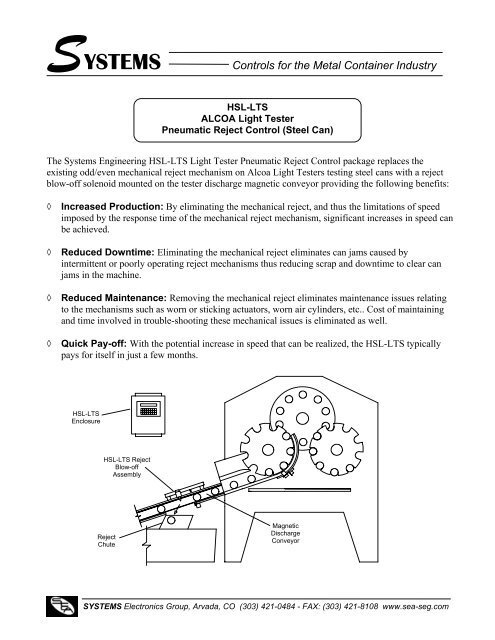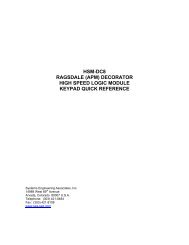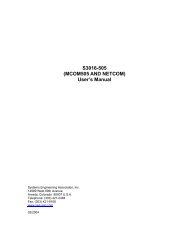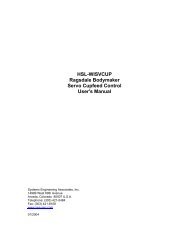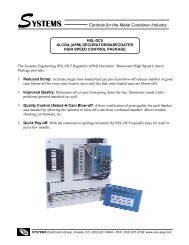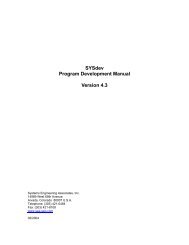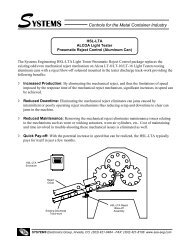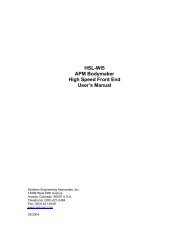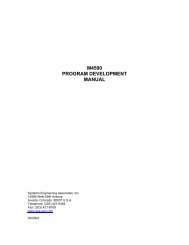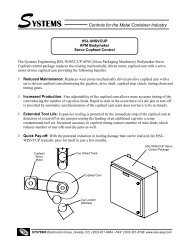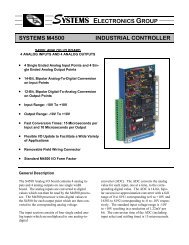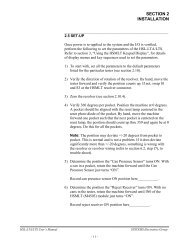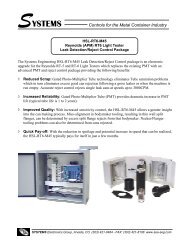HSL-LTS: Alcoa Light Tester Pneumatic Reject Control - Sea-Seg.com
HSL-LTS: Alcoa Light Tester Pneumatic Reject Control - Sea-Seg.com
HSL-LTS: Alcoa Light Tester Pneumatic Reject Control - Sea-Seg.com
You also want an ePaper? Increase the reach of your titles
YUMPU automatically turns print PDFs into web optimized ePapers that Google loves.
SYSTEMS<br />
<strong>Control</strong>s for the Metal Container Industry<br />
<strong>HSL</strong>-<strong>LTS</strong><br />
ALCOA <strong>Light</strong> <strong>Tester</strong><br />
<strong>Pneumatic</strong> <strong>Reject</strong> <strong>Control</strong> (Steel Can)<br />
The Systems Engineering <strong>HSL</strong>-<strong>LTS</strong> <strong>Light</strong> <strong>Tester</strong> <strong>Pneumatic</strong> <strong>Reject</strong> <strong>Control</strong> package replaces the<br />
existing odd/even mechanical reject mechanism on <strong>Alcoa</strong> <strong>Light</strong> <strong>Tester</strong>s testing steel cans with a reject<br />
blow-off solenoid mounted on the tester discharge magnetic conveyor providing the following benefits:<br />
◊<br />
◊<br />
◊<br />
◊<br />
Increased Production: By eliminating the mechanical reject, and thus the limitations of speed<br />
imposed by the response time of the mechanical reject mechanism, significant increases in speed can<br />
be achieved.<br />
Reduced Downtime: Eliminating the mechanical reject eliminates can jams caused by<br />
intermittent or poorly operating reject mechanisms thus reducing scrap and downtime to clear can<br />
jams in the machine.<br />
Reduced Maintenance: Removing the mechanical reject eliminates maintenance issues relating<br />
to the mechanisms such as worn or sticking actuators, worn air cylinders, etc.. Cost of maintaining<br />
and time involved in trouble-shooting these mechanical issues is eliminated as well.<br />
Quick Pay-off: With the potential increase in speed that can be realized, the <strong>HSL</strong>-<strong>LTS</strong> typically<br />
pays for itself in just a few months.<br />
<strong>HSL</strong>-<strong>LTS</strong><br />
Enclosure<br />
<strong>HSL</strong>-<strong>LTS</strong> <strong>Reject</strong><br />
Blow-off<br />
Assembly<br />
<strong>Reject</strong><br />
Chute<br />
Magnetic<br />
Discharge<br />
Conveyor<br />
SYSTEMS Electronics Group, Arvada, CO (303) 421-0484 - FAX: (303) 421-8108 www.sea-seg.<strong>com</strong>
Features<br />
• Replaces existing odd/even mechanical reject mechanism with a reject blow-off solenoid assembly mounted<br />
on the discharge magnetic conveyor of the tester to reject leak steel cans. Proprietary logic tracks cans from<br />
the leak detection array receiver to the blow-off location on the conveyor and accurately rejects leak cans at<br />
all speeds.<br />
• Performs high-speed control functions of <strong>Alcoa</strong> <strong>Light</strong> <strong>Tester</strong> to speeds in excess of 3,000 Cans Per Minute<br />
(machine mechanically permitting). This includes detection of leaker cans (interfaces with existing Leak<br />
detector arrays), rejection of leaker cans, alarm detection as well as data acquisition.<br />
• Optionally excepts reject input from vision inspection systems to incorporate rejection of inspected cans with<br />
leaker reject blow-off solenoid.<br />
• Upgrade package which interfaces with existing control system which includes: 14” X 12” X 8” control<br />
enclosure with <strong>Reject</strong> <strong>Control</strong> Module, <strong>Reject</strong> blow-off assembly (to be mounted on the discharge conveyor of<br />
the tester), Can Presence sensor and Resolver (to replace existing encoder for timing).<br />
• Performs the following control functions:<br />
• Interfaces with existing leak detector arrays to detect leak cans.<br />
• Tracks cans from leak detector to discharge mounted blow-off assembly to reject leak cans.<br />
• Optionally interfaces with vision inspection systems to reject visually defective cans.<br />
• Alarm detection: leak detection array fault, tester discharge can jam/back-up, timing signal failure, can<br />
presence sensor fail, photo eye lenses dirty fault, and missed reject detection (option).<br />
• Data Acquisition: Total number of good cans tested, total number of leaker rejects, total number of vision<br />
rejects, rejects per pocket, etc. (for both current and last shift).<br />
General Description<br />
The <strong>HSL</strong>-<strong>LTS</strong> <strong>Alcoa</strong> <strong>Light</strong> <strong>Tester</strong> pneumatic reject<br />
control package is an electronic upgrade for the <strong>Alcoa</strong><br />
<strong>Light</strong> <strong>Tester</strong> which replaces the existing mechanical<br />
odd/even reject mechanism with a reject blow-off<br />
solenoid mounted on the tester discharge magnetic<br />
conveyor thus allowing significant increases in speed.<br />
The package interfaces to the existing leak detection array<br />
receiver, tracks detected leak cans from the receiver to the<br />
blow-off location on the tester discharge conveyor, and<br />
accurately rejects the leak cans regardless of machine<br />
speed.<br />
The control package is not a dedicated “black box”, but<br />
instead is implemented using the high performance<br />
Systems M4503 PLC/PLS module which allows easy<br />
customization by either SEA or the end user. The module<br />
is programmed using the optional “SYSdev” (DOS based)<br />
software programming package which allows<br />
programming in any <strong>com</strong>bination of Ladder Logic or<br />
high-level (subset of “C”), as well as perform on-line<br />
monitoring and trouble-shooting. The module<br />
incorporates a built-in PLS which interfaces directly with<br />
the machine-mounted resolver and provides all machine<br />
timing, eliminating the need for an external PLS.<br />
Leaker <strong>Reject</strong> Blow-off System<br />
The package incorporates a reject blow-off assembly<br />
which is mounted on the tester discharge conveyor to<br />
reject detected leak cans. This replaces the existing<br />
mechanical odd/even reject mechanism thus allowing<br />
significant increases in speed. By eliminating the existing<br />
mechanical reject, limitations of machine speed relating<br />
to the response time of the mechanical reject are<br />
eliminated. The blow-off reject system is capable of<br />
accurately rejecting cans at speeds in excess of 3,000<br />
Cans Per Minute. Maintenance issues relating to the<br />
mechanical reject system (i.e. worn or sticking<br />
mechanical mechanisms, worn air cylinders, etc.) which<br />
result in missed rejects or intermittent can jams are<br />
eliminated as well. <strong>Light</strong> weighting of the discharge<br />
starwheel is achieved by removal of the mechanical<br />
reject, thus aiding in the potential increase in speed.<br />
The reject blow-off assembly consists of a bracket<br />
equipped with a high-speed blow-off solenoid and a fiber<br />
optic photo eye which is mounted on the tester discharge<br />
conveyor. In conjunction with a machine mounted Can<br />
Presence sensor and resolver, leak cans are tracked from<br />
the leak detector to the reject blow-off assembly where<br />
the cans are rejected.<br />
SYSTEMS Electronics Group, Arvada, CO (303) 421-0484 - FAX: (303) 421-8108 www.sea-seg.<strong>com</strong>
Vision Inspection System <strong>Reject</strong><br />
The package can optionally except a reject signal from a<br />
vision inspection system and reject these cans at the same<br />
discharge mounted reject blow-off solenoid. The vision<br />
system reject signal must occur between the infeed load<br />
location on the tester and the discharge of the tester. The<br />
vision reject signal must also be synchronized with the<br />
machine.<br />
Alarm Detection<br />
The package detects the following alarms: Leak Detection<br />
Array Fault, <strong>Tester</strong> Discharge Can Jam/Back-up, Timing<br />
Signal Fail, Can Presence Sensor Fail, Photo Eye Lenses<br />
Dirty Fault and Missed <strong>Reject</strong> Detection (option). The<br />
Leak Detection Array Fault occurs when a fault in a leak<br />
detector array head occurs. The <strong>Tester</strong> Discharge<br />
Jam/Back-up is generated if either a jam or back-up<br />
occurs at the discharge of the tester or if the <strong>Reject</strong> Photo<br />
Eye fails.<br />
The Timing Signal Fail occurs when any of the timing<br />
signals generated in the PLS section fails to change state<br />
periodically while the machine is running. Can Presence<br />
Sensor Fail occurs when the sensor fails to detect cans<br />
while cans are flowing through the machine. The Photo<br />
Eye Lenses Dirty Fault indicates that the lenses of the<br />
photo eye mounted on the <strong>Reject</strong> Blow-off assembly are<br />
contaminated and need to be cleaned or are damaged and<br />
need to be repaired. The Missed <strong>Reject</strong> Detection occurs<br />
when a can is not detected as being rejected when the<br />
reject blow-off is activated. This alarm is implemented<br />
using the optional <strong>HSL</strong>-LTRV reject verification sensors<br />
which are mounted in the reject chute.<br />
Data Collection<br />
The following data is collected for both the current shift<br />
and the previous (last) shift: Total number of good cans<br />
tested, total number of leak cans rejected, total number of<br />
vision rejects, and the total rejects per pocket. This data is<br />
viewed on the display of the <strong>HSL</strong>-<strong>LTS</strong>. The information<br />
is updated (“current” shift transferred to “last” shift)<br />
based on the change of state of a discrete input.<br />
In addition to the shift data collection, a separate buffer is<br />
available to collect rejects per pocket counts as a<br />
diagnostics aid to the operator for trouble-shooting a light<br />
seal problem on a specific pocket. Unlike the shift data,<br />
these counts can be reset manually by the operator at will.<br />
This allows the operator to note an abnormally high count<br />
on a specific pocket, attempt to correct the problem, reset<br />
the counts and then check the counts at a later time to<br />
determine if the problem is corrected.<br />
<strong>HSL</strong>-<strong>LTS</strong> Keypad / Display<br />
The <strong>HSL</strong>-<strong>LTS</strong> package is based on the M4503<br />
PLC/PLS/Display module. The keypad of the M4503<br />
contains 24 keys consisting of data display <strong>com</strong>mands,<br />
setup <strong>com</strong>mands, and a numeric keypad. The display of<br />
the M4503 is a 2 line by 40 character back-lit LCD<br />
display which displays the selected data and setup menus.<br />
The keypad/display can be used by the operator to view<br />
the current and last shift data as well as the rejects per<br />
pocket diagnostic data. In addition, the keypad/display is<br />
used to activate the <strong>Reject</strong> Blow-off Solenoid test feature<br />
and can be used by authorized personnel (passcode or key<br />
switch protected) to adjust the timing and all setup<br />
parameters.<br />
“HSMLT” Setup Program<br />
The “HSMLT” setup program allows the user to easily<br />
view the <strong>HSL</strong>-<strong>LTS</strong> data or alter the <strong>HSL</strong>-<strong>LTS</strong> setup<br />
variables using an IBM PC or <strong>com</strong>patible. These<br />
variables include: Can Presence to discharge number of<br />
shifts, leak detector to discharge number of shifts, vision<br />
reject to discharge number of shifts, Can neck size, <strong>Reject</strong><br />
pulse time, and the machine timing set-points. In addition<br />
to setting the variables, “HSMLT” can be used to view<br />
the current and last shift data, view the rejects per pocket,<br />
download the <strong>HSL</strong>-<strong>LTS</strong> application program to the<br />
M4503 as well as download and upload the setup data to<br />
the M4503.<br />
<strong>Tester</strong> Requirements<br />
The reject blow-off assembly is mounted at the immediate<br />
exit of the tester. The can is rejected down off a magnetic<br />
conveyor located at the discharge of the tester. If the<br />
tester does not already have a magnetic conveyor at the<br />
immediate tester exit (such as a gravity track instead), one<br />
will have to be added. The reject blow-off assembly is<br />
mounted on this magnetic conveyor and blows the can<br />
down, either into a reject chute or bucket. The magnetic<br />
conveyor and reject chute are not provided as part of the<br />
<strong>HSL</strong>-<strong>LTS</strong> package.<br />
SYSTEMS Electronics Group, Arvada, CO (303) 421-0484 - FAX: (303) 421-8108 www.sea-seg.<strong>com</strong>
Specifications<br />
Power Requirements:<br />
Voltage: 100-240VAC, 50/60HZ<br />
Current: 0.5 Amps @ 115VAC<br />
0.25 Amps @ 230VAC<br />
Voltage: +24VDC<br />
Current: 2.0 Amps<br />
Compressed Air: 90-110psi @ 0.25 SCFM<br />
Temperature Ranges:<br />
Operating: 0 to 55°C<br />
Storage: 0 to 70°C<br />
Resolver Interface:<br />
Resolver Type: Systems Electronics Group<br />
RSV34-MS1<br />
Resolver Cable: Systems Electronics Group<br />
RSV-RSCBLE-XX<br />
<strong>Control</strong> Inputs:<br />
Voltage Range: 10-30VDC<br />
Input “On” Voltage (min): 10.0 volts<br />
Input “On” Voltage (max): 30.0 volts<br />
Input “Off” Voltage (max): 5.0 volts<br />
Input Current (max): 15 milliamps @ Vin=30V<br />
Optical Isolation: 1500 Vrms<br />
Outputs:<br />
Voltage Range: 10-30VDC<br />
Output “On” Voltage (min): VCC-2.00 volts<br />
Output “On” Voltage (max): VCC-0.25 volts<br />
Output “Off” Voltage (max): 1.5 volts<br />
Output “On” Current (max-cont): 0.5 Amps DC<br />
Output “On” Current (100msec): 3.0 Amps DC<br />
Optical Isolation: 1500 Vrms<br />
Ordering Information<br />
The <strong>HSL</strong>-<strong>LTS</strong> package includes a 14” X 12” X 8” NEMA 12 enclosure which should be mounted in close proximity to<br />
the tester. An addition, a reject blow-off assembly is provided which is mounted on the discharge conveyor of the tester.<br />
The order number for the <strong>HSL</strong>-<strong>LTS</strong> is as follows:<br />
Part Number<br />
<strong>HSL</strong>-<strong>LTS</strong><br />
Description<br />
<strong>Alcoa</strong> <strong>Light</strong> <strong>Tester</strong> <strong>Pneumatic</strong> <strong>Reject</strong> <strong>Control</strong> package (for steel can)<br />
including the following:<br />
1ea.<br />
1ea.<br />
1ea.<br />
1ea.<br />
1ea.<br />
1ea.<br />
1ea.<br />
1ea.<br />
1ea.<br />
<strong>HSL</strong>-LTA/<strong>LTS</strong> Enclosure (14” X 12” X 8”) with M4503 <strong>Reject</strong><br />
<strong>Control</strong> Module.<br />
BRK-LTB-SOL <strong>Reject</strong> Blow-off Assembly with blow-off<br />
solenoid and Fiber Optic Photo Eye.<br />
BRK-LTB-HD Hardware Kit including mounting brackets.<br />
BRK-LTB-PRX Can Presence Sensor<br />
RSV34-MS1 Resolver<br />
RSV-RSCBLE-100 Resolver Cable<br />
<strong>HSL</strong>-LTA/<strong>LTS</strong> User’s Manual<br />
<strong>HSL</strong>-LTA/<strong>LTS</strong> Program Disk<br />
M4500 User’s Manual<br />
<strong>HSL</strong>-<strong>LTS</strong> Options (purchased separately)<br />
Part Number<br />
<strong>HSL</strong>-LTRV<br />
Description<br />
<strong>Reject</strong> Verification Sensors (to be mounted in reject chute)<br />
SYSTEMS Electronics Group, Inc.<br />
Division of SYSTEMS Engineering Associates, Inc.<br />
14989 W. 69 th Ave., Arvada, CO 80007<br />
Telephone: (303) 421-0484 FAX: (303) 421-8108 www.sea-seg.<strong>com</strong>


